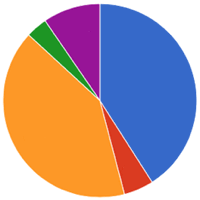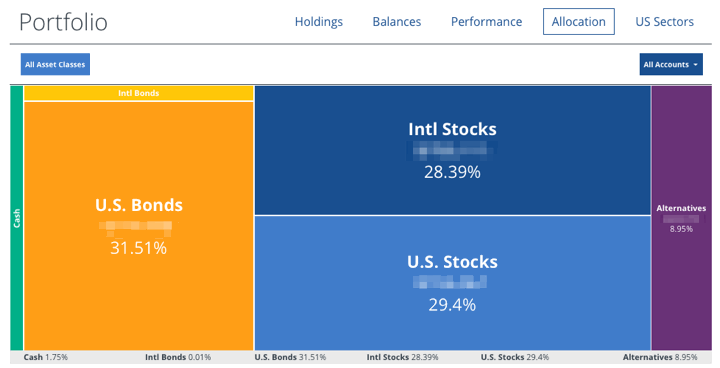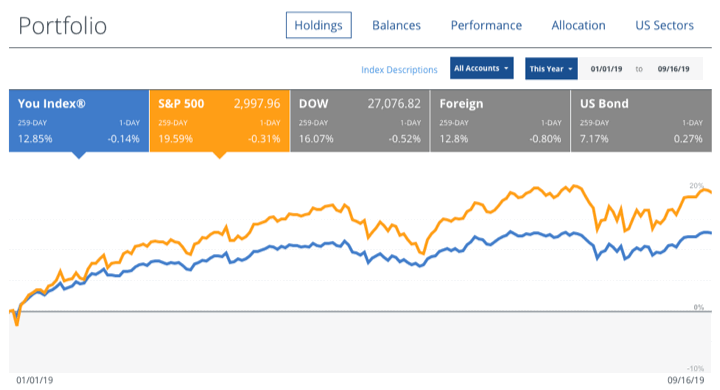
Here’s my portfolio update for the third quarter of 2019. Most of my dividends arrive on a quarterly basis, and this helps me determine where to reinvest them. These are my real-world holdings, including 401k/403b/IRAs, taxable brokerage accounts, and savings bonds but excluding our house, cash reserves, and a few side investments. The goal of this portfolio is to create sustainable income that keeps up with inflation to cover our household expenses.
Actual Asset Allocation and Holdings
I use both Personal Capital and a custom Google Spreadsheet to track my investment holdings. The Personal Capital financial tracking app (free, my review) automatically logs into my accounts, adds up my balances, tracks my performance, and calculates my asset allocation. I still use my manual Google Spreadsheet (free, instructions) because it helps me calculate how much I need in each asset class to rebalance back towards my target asset allocation.
Here are my YTD performance and current asset allocation visually, per the “Holdings” and “Allocation” tabs of my Personal Capital account, respectively:


Stock Holdings
Vanguard Total Stock Market Fund (VTI, VTSAX)
Vanguard Total International Stock Market Fund (VXUS, VTIAX)
WisdomTree SmallCap Dividend ETF (DES)
Vanguard Small Value ETF (VBR)
Vanguard Emerging Markets ETF (VWO)
Vanguard REIT Index Fund (VNQ, VGSLX)
Bond Holdings
Vanguard Limited-Term Tax-Exempt Fund (VMLTX, VMLUX)
Vanguard Intermediate-Term Tax-Exempt Fund (VWITX, VWIUX)
Vanguard Intermediate-Term Treasury Fund (VFITX, VFIUX)
Vanguard Inflation-Protected Securities Fund (VIPSX, VAIPX)
Fidelity Inflation-Protected Bond Index Fund (FIPDX)
iShares Barclays TIPS Bond ETF (TIP)
Individual TIPS securities
U.S. Savings Bonds (Series I)
Target Asset Allocation. Our overall goal is to include asset classes that will provide long-term returns above inflation, distribute income via dividends and interest, and finally offer some historical tendencies to balance each other out. I make a small bet that US Small Value and Emerging Markets will have higher future long-term returns (along with some higher volatility) than the more large and broad indexes, although I could be wrong.
I don’t hold commodities, gold, or bitcoin. While you could argue for each of these asset classes, I believe that it is important to imagine an asset class doing poorly for a long time, with bad news constantly surrounding it, and only hold the ones where you still think you can maintain faith based on a solid foundation of knowledge and experience. That’s just not the case for me with certain asset classes.
Stocks Breakdown
- 38% US Total Market
- 7% US Small-Cap Value
- 38% International Total Market
- 7% Emerging Markets
- 10% US Real Estate (REIT)
Bonds Breakdown
- 33% US Treasury Bonds, intermediate
- 33% High-Quality Municipal Bonds (taxable)
- 33% US Treasury Inflation-Protected Bonds (tax-deferred)
I have settled into a long-term target ratio of 67% stocks and 33% bonds (2:1 ratio) within our investment strategy of buy, hold, and occasionally rebalance. I will use the dividends and interest to rebalance whenever possible in order to avoid taxable gains. (I allow it drift a bit either way.) With a self-managed, simple portfolio of low-cost funds, we minimize management fees, commissions, and taxes.
Holdings commentary. On the stocks side, somehow despite all of the various news stories stock prices have been resilient. I’m like a lot of other people and waiting for the next recession to come, but I also know to stay in the game. US stocks have beaten international stocks for a while, but I remain satisfied with my mix, knowing that I will own whatever successful businesses come out of the US, China, or wherever in the future.
On the bond side, my primary objective is to hold high-quality bonds with a short-to-intermediate duration of under 5 years or so. This means US Treasuries, TIPS, or investment-grade municipal bonds. I don’t want to worry about my bonds. I then tweak the specific breakdown based on my tax-deferred space available, the tax-effective rates of muni bonds, and the real interest rates of TIPS. Right now, it is roughly 1/3rd Treasuries, 1/3 Muni bonds, and 1/3rd TIPS. It looks like I need to redirect my dividends into more bonds.
Performance commentary and benchmarks. According to Personal Capital, my portfolio went up 13% so far in 2019. I see that during the same period the S&P 500 has gone up nearly 20%, Foreign Developed stocks up nearly 13%, and the US Aggregate bond index was up about 7%.
An alternative benchmark for my portfolio is 50% Vanguard LifeStrategy Growth Fund and 50% Vanguard LifeStrategy Moderate Growth Fund – one is 60/40 and the other is 80/20 so it also works out to 70% stocks and 30% bonds. That benchmark would have a total return of +14.82% for 2019 YTD.
I’ll share about more about the income in a separate post.
 The Best Credit Card Bonus Offers – 2025
The Best Credit Card Bonus Offers – 2025 Big List of Free Stocks from Brokerage Apps
Big List of Free Stocks from Brokerage Apps Best Interest Rates on Cash - 2025
Best Interest Rates on Cash - 2025 Free Credit Scores x 3 + Free Credit Monitoring
Free Credit Scores x 3 + Free Credit Monitoring Best No Fee 0% APR Balance Transfer Offers
Best No Fee 0% APR Balance Transfer Offers Little-Known Cellular Data Plans That Can Save Big Money
Little-Known Cellular Data Plans That Can Save Big Money How To Haggle Your Cable or Direct TV Bill
How To Haggle Your Cable or Direct TV Bill Big List of Free Consumer Data Reports (Credit, Rent, Work)
Big List of Free Consumer Data Reports (Credit, Rent, Work)
Like you I have had I Series Savings Bonds as part of my portfolio. I purchased them in 2005 with a 1% fixed rate. I bought them for several reasons, at the time I was able to buy $30K in paper and $30K via Treasury Direct. One reason was they are not subject to the NH (state in I live in) Dividend and Interest tax. They have averaged about 3.3% annual return since 2005. I am 62 and now closing in on the midpoint of ownership of 30 years. As you know when I bonds reach 30 years maturity they stop paying interest. I may be alive to see them reach their maturity. I will then be forced to choose to leave them sit and earn no interest or take a large taxable interest hit if I redeem them. I am thinking that I will slowly redeem them over the last 10 years of their “life”. Have you thought about this and what you will do when they reach their 30 year maturity date?
Thank you, Jonathan, for another interesting post. You seem to be a Vanguard fan…have you ever considered one of their Target Retirement Funds?
He basically has a target date fund, but it’s self-made because he is trying to control his tax situation (bonds pay interest, stocks pay capital gains, tax-gain harvesting, tax-loss harvesting, etc)
International and emerging markets have been doing so poorly.
True, but that means the CAPE (PE10) ratio for the US is 30, international developed is 21, and emerging markets is 16. The price/earnings valuation number is a lot higher for the US. I don’t time based on the PE/10 ratio, but I do pay attention to it.
Sort of on the same note, have you ever considered diversifying your bonds to include international bonds?
I have thought about it, but I don’t agree with Vanguard on international bonds. I don’t think they are safer for a variety of reasons including currency risk, and so that really takes away the main reason I hold bonds. I want something that I don’t worry about in times of crisis, even though that may just be a personal bias. I will stick with US Treasuries and FDIC-insured bank CDs.